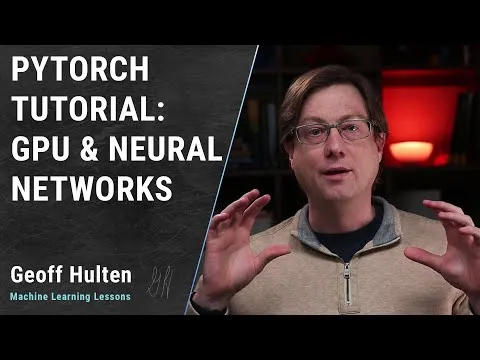
Intro to Machine Learning with Pytorch Course 
This course provides an introduction to machine learning using Pytorch, covering data cleaning, supervised models, and deep and unsupervised learning. Participants will gain a foundational understanding of machine learning algorithms. ▼
ADVERTISEMENT
Course Feature
![]() Cost:
Cost:
Paid
![]() Provider:
Provider:
Udacity
![]() Certificate:
Certificate:
No Information
![]() Language:
Language:
English
![]() Start Date:
Start Date:
Self Paced
Course Overview
❗The content presented here is sourced directly from Udacity platform. For comprehensive course details, including enrollment information, simply click on the 'Go to class' link on our website.
Updated in [March 06th, 2023]
This Intro to Machine Learning with Pytorch Course provides an introduction to the fundamentals of machine learning. Students will learn the difference between regression and classification, and how to train a linear regression model to predict values. Additionally, students will learn how to use logistic regression to predict states. By the end of the course, students will have a better understanding of the basics of machine learning and how to use Pytorch to implement them.
[Applications]
After completing this course, students can apply their knowledge of Machine Learning with Pytorch to a variety of tasks. They can use Linear Regression to predict values, and Logistic Regression to predict states. Additionally, they can use the knowledge gained to build more complex models, such as Neural Networks, to solve more complex problems. Furthermore, they can use the skills learned to explore other Machine Learning libraries, such as TensorFlow, and apply them to their own projects.
[Career Paths]
1. Data Scientist: Data Scientists use machine learning algorithms to analyze large datasets and uncover patterns and insights. They use these insights to develop predictive models and create data-driven solutions. With the increasing availability of data, the demand for Data Scientists is growing rapidly.
2. Machine Learning Engineer: Machine Learning Engineers are responsible for building and deploying machine learning models. They use PyTorch and other frameworks to develop and optimize models, and use cloud computing to deploy them. As the demand for AI-driven solutions increases, the demand for Machine Learning Engineers is also growing.
3. AI Developer: AI Developers use machine learning algorithms to create AI-driven applications. They use PyTorch and other frameworks to develop and optimize AI models, and use cloud computing to deploy them. As the demand for AI-driven solutions increases, the demand for AI Developers is also growing.
4. Research Scientist: Research Scientists use machine learning algorithms to conduct research and develop new algorithms. They use PyTorch and other frameworks to develop and optimize models, and use cloud computing to deploy them. As the demand for AI-driven solutions increases, the demand for Research Scientists is also growing.
[Education Paths]
1. Bachelor of Science in Computer Science: This degree path provides a comprehensive overview of computer science fundamentals, including programming, algorithms, data structures, and software engineering. It also covers topics such as artificial intelligence, machine learning, and robotics. With the increasing demand for machine learning and artificial intelligence, this degree path is becoming increasingly popular.
2. Bachelor of Science in Data Science: This degree path focuses on the analysis and interpretation of data. It covers topics such as data mining, data visualization, and predictive analytics. It also covers machine learning and artificial intelligence, as well as the use of programming languages such as Python and R. This degree path is becoming increasingly popular as businesses and organizations look to leverage data to make better decisions.
3. Master of Science in Artificial Intelligence: This degree path focuses on the development of intelligent systems. It covers topics such as natural language processing, computer vision, and robotics. It also covers machine learning and deep learning, as well as the use of programming languages such as Python and TensorFlow. This degree path is becoming increasingly popular as businesses and organizations look to leverage artificial intelligence to automate processes and make better decisions.
4. Master of Science in Machine Learning: This degree path focuses on the development of machine learning algorithms and models. It covers topics such as supervised and unsupervised learning, neural networks, and reinforcement learning. It also covers the use of programming languages such as Python and TensorFlow. This degree path is becoming increasingly popular as businesses and organizations look to leverage machine learning to automate processes and make better decisions.
Course Syllabus
Learn the definition of a perceptron as a building block for neural networks, and the perceptron algorithm for classification.
Course Provider

Provider Udacity's Stats at AZClass
Discussion and Reviews
0.0 (Based on 0 reviews)
Explore Similar Online Courses

Creative Furniture Upcycling for Beginners

Free Audio Engineering Tutorial - Audio Engineering: How to prepare and share sessions & files

Python for Informatics: Exploring Information

Social Network Analysis

Introduction to Systematic Review and Meta-Analysis

The Analytics Edge

DCO042 - Python For Informatics

Causal Diagrams: Draw Your Assumptions Before Your Conclusions

Whole genome sequencing of bacterial genomes - tools and applications

PyTorch Tutorial - Neural Networks & GPU

Applied Deep Learning with PyTorch - Full Course

Intro to Deep Learning with PyTorch
 Related Categories
Related Categories
 Popular Providers
Popular Providers
Quiz
 Submitted Sucessfully
Submitted Sucessfully
1. What is the main difference between Regression and Classification?
2. What type of model is used to predict values?
3. What type of model is used to predict states?


Start your review of Intro to Machine Learning with Pytorch Course